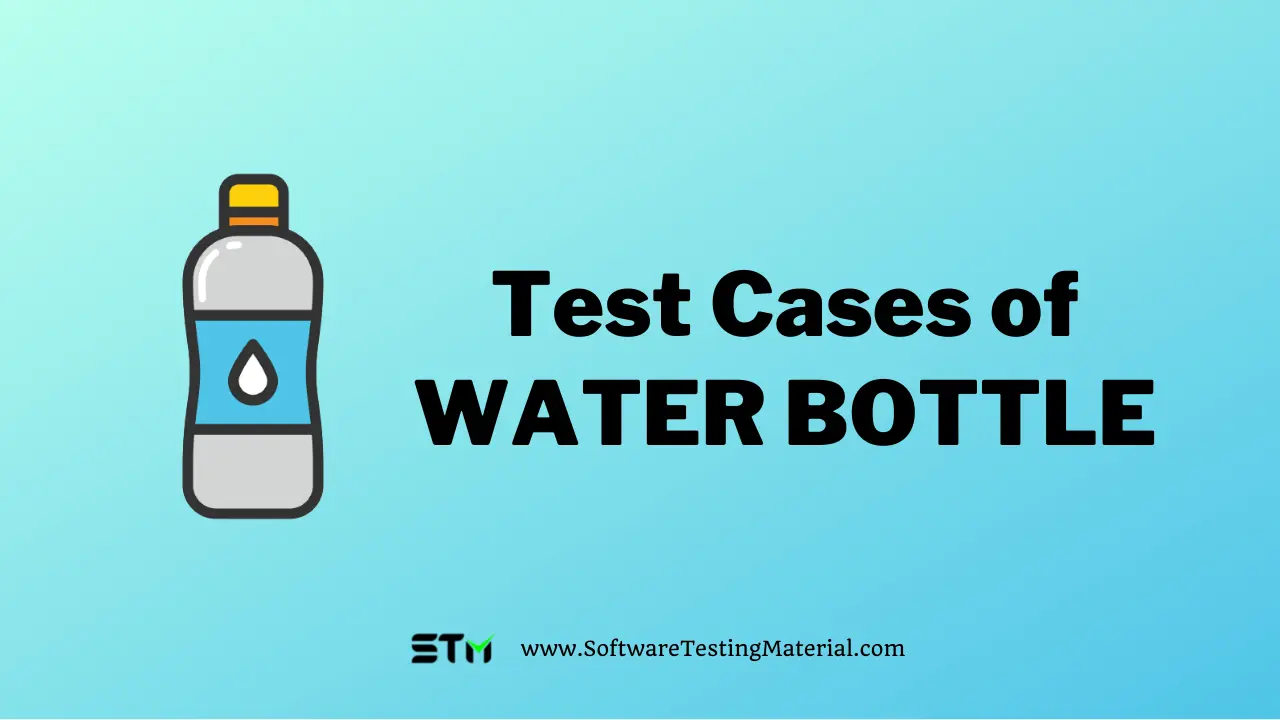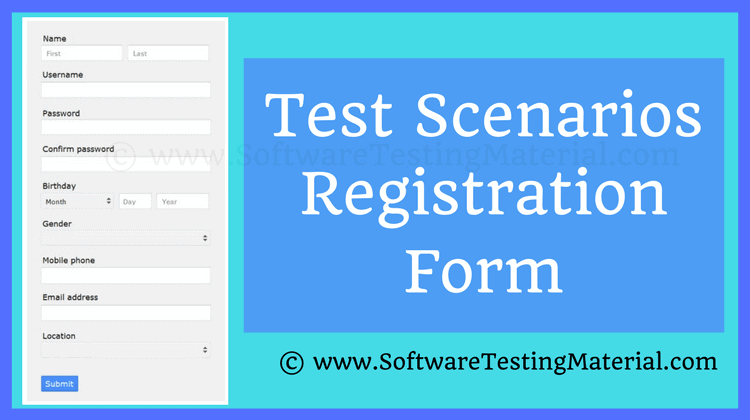50+ Test Cases For Water bottle | Test Scenarios For Water Bottle
In this article, we will walk through how to write test cases for water bottle. It is one of the common manual testing interview questions where the interviewer asks the candidates to write test cases for daily use products.
These questions will help the interviewer to evaluate the candidate’s thought process.
Usually, these questions are the deal breakers in interviews. A candidate may be well-versed in testing concepts, but when asked to write test cases for a random product, they might miss the objective. The first step is to understand the product’s requirements. A good tester always strives to comprehend the product and its expectations before beginning their testing.
Earlier we have discussed some of the related posts and here are those for your reference.
- Test Case Template with Detailed Explanation
- Test Cases for Registration Page
- Test Cases for Login Page
- Test Cases for Gmail
- Test Cases for ATM Machine
- Test Scenario vs Test Case
- Test Strategy vs Test Plan
- 8 Types of Test Cases To Be Automated
- 8 Types of Test Cases Not To Be Automated

Water Bottle Test Cases
Requirements
- What is the material of the water bottle, is it a bottle made of glass, plastic, rubber, some metal, some kind of disposable material, or other material?
- Is there any alternate purpose for the water bottle, is it meant only to hold water, or can we use it with other fluids like tea, coffee, soft drinks, hot chocolate, soups, wine, cooking oil, vinegar, gasoline, acids, etc.?
- Who are the target users of this water bottle? A school-going kid, a housewife, some beverage manufacturing company, an office-goer, a sportsman, an Eskimo living in an igloo, or an astronaut in a spaceship?
Thought Process
After understanding the requirements, you should begin thinking about how to connect the product to the testing concepts. You should think in the line where you display your testing knowledge through these test cases.
Basic Functionality
- Core Functionality: The water bottle should hold water.
- Boundary conditions: The amount of water the bottle can hold
- Stress Condition: The water bottle should not break when pouring water that exceeds its capacity.
- Usability Condition: The user should be able to open and drink from the water bottle
- Security/Safety Condition: The water bottle should not be made of harmful chemicals.
Functional Test Cases For Water Bottle
- Check the shape and size of the water bottle as per requirement.
- Check whether the user can pour the water inside the bottle easily or not.
- Check the type of bottle – with a lid or without a lid.
- Check whether the bottle is designed with a sipper or without a sipper.
- Check whether the water bottle can hold water as per the volume specified in the requirements.
- Check whether the user can drink water from the bottle.
- Check whether the caps fit with the bottle or not.
- Check whether the water bottle stays stable on a flat surface.
- Check whether the water bottle can sustain the temperature of the water if it’s a thermal water bottle.
- Check whether the water bottle is durable for a long time.
User Interface Test Cases For Water Bottle
- Check whether the colour of the water Bottle is as per the specification
- Check whether the brand name is seen on the water bottle.
- Check whether the brand logo is visible on the water bottle.
- Check whether the dimensions of the bottle are as per the specifications.
- Check whether the weight of the bottle is as per the specifications.
- Check whether the material of the water bottle is Plastic, steel, etc as expected.
- Check whether the water bottle lid fits the bottle.
- Check whether the mouth of the bottle is as per specifications.
- Check whether the bottle is disposable or reusable.
- Check whether the expiry date is mentioned or not.
- Check whether the water bottle is lightweight to carry.
- Check whether the water bottle is dishwasher safe.
- Check whether the designs get scratched off or faded over time
- Check whether the water bottle is resistant to rust or mould if it’s a stainless steel bottle.
- Check whether the water bottle is easy to clean.
Usability Test Cases For Water Bottle
- Check whether the water bottle doesn’t leak when tilted or placed upside down.
- Check whether the lid of the bottle is firmly tightened with a bottle.
- Check whether the bottle’s material is brittle.
- Check whether the expiry date is mentioned in the bottle or not
- Check whether the user can hold the water bottle comfortably.
- Check whether there is any chemical change in the water after keeping it in the bottle, and check whether the bottle is safe to be consumed as drinking water.
- Check whether the bottle is made up of material, which is recyclable.
- Check whether the bottle is easily crushable if it’s made of plastic.
- Check whether the bottle can also be used to hold other common household things like honey, fruit juice, fuel, paint, turpentine, liquid wax, etc.
- Check whether the bottle contains a nozzle cleaner if the bottle has a sipper in it.
- Check whether the nozzle cleaner cleans the sipper nozzle.
- Check whether the bottle is ergonomically designed and if it is comfortable to hold.
- Check whether the bottle doesn’t topple, both when empty and full, the centre of gravity should stay low.
- Check whether the bottle cap can be closed with thread or directly fixed into the bottle.
- Check whether the water bottle is easy to carry anywhere.
- Check whether the water bottle is safe for children ( glass bottles are not safe for children)
Boundary Test Cases For Water Bottle
- Check the maximum temperature of the liquid allowed.
- Check the minimum temperature of the liquid allowed.
- Check the water bottle’s condition with different liquids – water, tea, milkshake, etc.
- Check how much time it takes for the liquid to arrive at room temperature, ie verifying the insulation of the bottle.
- Check whether the bottle leaks or not by filling it full with water and checking it by putting that in a dry space.
- Check whether the bottle shows unexpected behaviour when placing it in a refrigerator for cooling and see how it reacts at different temperatures.
- Check whether the gets subjected to any physical or chemical deformation when keeping it dry for a very long time.
- Check whether the smell of the water changes by putting the water in for some time.
- Check whether the water-filled bottle breaks when dropped from a specific height.
- Check whether the empty bottle breaks when dropped from a specific height.
- Check the empty water bottle’s condition in the freezer.
- Check the empty water bottle’s condition in the freezer.
- Check whether the bottle handles various temperature conditions.
Negative Test Scenarios For Water Bottle
- Check how the bottle handles when pouring liquid at a very high temperature, more than the permissible value.
- Check how the bottle handles when pouring liquid at a very low temperature, less than the permissible value.
- Check how the bottle handles when subjected to a very high temperature.
- Check how the bottle handles when pouring liquid/gas at very high pressure, more than the normal pressure.
- Check whether the bottle leaks when tilted, inverting, or squeezed (in the case of the plastic-made bottle).
- Check whether a water-filled bottle can handle being in the refrigerator for a very long time (say a week).
- Check whether the water bottle expands (if plastic-made) or breaks (if glass made) when placing a water-filled bottle under freezing conditions.
- Check how the water bottle handles when keeping it in a microwave oven.
- Check whether the water-filled bottle breaks when dropped from a specific height.
- Check whether the empty bottle breaks when dropped from a specific height.
- Check whether the water bottle(if it’s a glass bottle) breaks into tiny little pieces which are often difficult to clean or breaks into nice large pieces which could be cleaned without much difficulty.
- Check whether the water bottle fades in the sun
- Check whether the water bottle doesn’t dent easily if dropped or banged.
- Check whether the water bottle doesn’t contain any harmful chemicals in its material.
Test Data
When performing testing on a product or an application, you should know exactly in which variation in the product or surface we are testing it. In the context of random product testing, test data is nothing but data that is specifically created for input for a certain test.
In the context of water test cases, our test data would be the type of water bottle we have to use, the type of lid etc.
There are several types of the water bottle in the market:
- Plastic water bottle
- Aluminium water bottle
- Stainless steel water bottle
- Glass water bottle
- Copper water bottle
- Squeeze/sports water bottle
- BPA-free water bottle
- Built-in infuser water bottle
- Insulated water bottle
- Collapsible water bottle
- Eco-friendly water bottle
- Colour-changing water bottle
- Glow in the dark water bottle
- Smart water bottle
There are multiple types of the lid for a water bottle
- Screw on Cap
- Attached carabiner
- Flip up cap
- Pullover cap
- Sliding cap
- Push button cap
- Flip up cap
- Push-pull cap
- Attached screw-on Cap
- Screw on with straw
- Straw with cap
- Cork
- Hinged cap
- Build-in handle cap
Conclusion
The above test cases are just a few ideas on how you can write test cases for water bottles. Here you can take this as a mental exercise to write more test cases for various random products. Hope this article has covered the required test scenarios for water bottle.
Related posts:
- How To Write a Good Defect Report
- Why Did You Choose Software Testing As A Career
- Test Plan Template Detailed Explanation
- Web Cookie Testing – Test Cases of Cookie Testing







